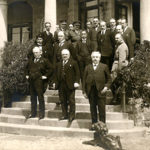Published September 4, 1986
The Wall Street Journal
Since 1971 the world has suffered two great inflations and three recessions. Hopes for a world-wide economic expansion have been interrupted once again, by an economic slowdown and the threat of a trade war. Will the world ever settle down to sustained noninflationary growth?
Unfortunately, no-not unless a basic flaw in the world monetary system is corrected. Each succeeding crisis is a different symptom of the same disorder. Each succeeding crisis is a different symptom of the same disorder.
The institutional flaw concerns the choice of international monetary reserves. We all need monetary reserves. Reserves are the “final asset” that bridges the gaps between our sales and purchases of goods, and bonds (promises of future goods).
The main problem is that the international reserves financing world growth and trade consist basically of U.S. dollars—financial claims on the U.S. The dollar is the “official reserve currency.” This means that the “reserves” of the Bundesbank or Bank of Japan are not held in Frankfurt or Tokyo but invested in New York.
Why is this a problem? Because there never can be a net increase in the world monetary reserves. The dollar is an asset for foreign central banks, but it is a liability for the U.S.; it must be paid sooner or later in goods. So other countries can increase their reserves only if the if the U.S. increases its net reserve indebtedness with a balance-of-payments deficit. The U.S. can increase its liquidity only at the expense of other countries. This has made the attempt to gain reserves—and trade surpluses—a zero-sum game.
Bretton Woods Breakdown
The problems arising from the dollar’s reserve-currency role are basically the same ones that led to the breakdown of the sterling-based monetary system established at the 1922 Genoa conference, and the dollar-based system established by the 1944 Bretton Woods agreement. (We sometimes think of these monetary systems as spanning halcyon decades, but they actually operated without major restrictions only in 1925-31 and 1959-1968.)
Under both systems, Britain or the U.S. redeemed its currency in gold, while other countries used pounds sterling or dollars as official reserves. Around 1960, economists Robert Triffin and Jacques Rueff accurately predicted that Bretton Woods had to break down just like the sterling-based system, because the gain in official reserves by other countries was being supplied by net reserve losses of the U.S., which could not last. Bretton Woods officially ended with the suspension of dollar-gold convertibility in 1971, just as Britain suspended the gold standard in 1931.
With the dollar no longer convertible into gold, the attempt after the Smithsonian agreement of 1971 to peg other currencies to the dollar without dollar-gold convertibility exploded within 15 months, resulting in the current managed float. But neither the dollar’s inconvertibility nor greater exchange-rate flexibility lessens the problems created by the dollar’s reserve currency role. The same effects occur in real terms whether exchange rates are fixed or floating. Today, governments seek to relieve the pressures that blew apart Bretton Woods and the Smithsonian system through increasingly wild exchange-rate swings—but only at the cost of a continuous lurch from one state of disequilibrium to another.
The dollar’s reserve-currency role has always had two attractions: It allows other countries to earn interest on their reserves (unlike gold), and it permits the U.S. to acquire foreign and domestic wealth with all the reserves lent us by other countries. However, this subjects the other countries to the risk of exchange losses and the tax of U.S. inflation on their reserves. And acting as the world’s banker tends to diminish U.S. public and private saving and promote an “overvaluation” of the U.S. dollar (like sterling in the 1920s).
These effects are usually associated with an increase in national wealth. They are created under the reserve-currency system by government-to-government borrowing that makes the U.S. private sector feel wealthier even as Washington takes advantage of its greater ease of borrowing. One might say that the reserve-currency system makes the U.S. behave as if it were richer, and other countries as if they were poorer, than they really are. The reserve-currency system encourages American industrial decline, yet leaves us with a monetary system in which the reserves of other countries can increase only in the largest debtor nation in the world goes further into debt.
This explains why no lasting equilibrium is compatible with steady noninflationary growth. When the rest of the world demands dollar reserves to accommodate economic growth, the real dollar exchange rate rises and the leverage of the U.S. financial system increases. But easing U.S. monetary policy to promote a “competitive” dollar and re-liquefy the domestic economy causes either inflation or economic contraction in other countries—depending on whether foreign central banks respond by letting their currencies appreciate or by defensively inflating.
Some argue that we could avoid this if Germany and Japan used fiscal rather than monetary policy to stimulate domestic demand, thus “rebalancing” world growth and U.S. trade. Desirable as initiatives like tax reform are on other grounds, this theory wrongly assumes that the monetary system is symmetrical—that the deutsche mark and the yen are as important as the dollar. For all practical purposes, Germany and Japan can only acquire and spend monetary reserves; they cannot create them. Higher growth abroad would increase the demand for U.S. exports, but it would increase the demand for dollar reserves, offsetting much of the hoped-for gain to U.S. trade.
It’s sometimes pointed out that all nations are trying to achieve a trade surplus at the same time. We are generally reminded that not everyone can have a balance-of-payments surplus. But this is not true. In fact, before the existence of official national-reserve currencies, it was normal for the world economy to have a trade surplus with itself.
Under the old gold standard, the world’s demand for new monetary reserves was met by mining and minting gold. The world’s net exports equaled the increase in monetary gold. Through this mechanism the gold standard maintained average price stability in the long run and even provided a kind of contracyclical job-creation policy. Periods of general prosperity and rising commodity prices tended to depress gold production, since gold’s price was fixed but its cost of production was rising. During depressions, deflation and unemployment in other industries stimulated increased employment in the gold industry, because gold’s price was fixed but its cost of production was falling.
Ironically, when John Maynard Keynes proposed anti-recessionary deficit spending 50 years ago, his theoretical model, as the General Theory makes clear, was the per-1914 gold standard. Keynes simply argued (like many economists since) that building roads and harbors on the cuff is more useful to society than mining gold.
But Keynes overlooked a crucial fact: Since debt must be paid off in real terms by someone, deficit spending alone cannot provide a permanent addition to real incomes: gold, being an asset that is not someone else’s liability, can.
The inescapable conclusion is that without restoring something strongly resembling the international gold standard we cannot solve the world’s systemic monetary and trade problems. To end the zero-sum scramble for monetary reserves and trade surpluses, we must restore an international money that is an asset without being any nation’s liability. This rules out national-reserve currencies like the dollar. It also rules out a currency issued, say, by the IMF, since that would not be a net asset either. The “resource cost” of using gold as money, which is often claimed to be a drawback, is in fact a major advantage. Unless the world’s “final asset” is a real commodity, there can never be an increase in net reserves. And unlike paper money, the production of gold adds to real as well as nominal income.
The world monetary system could regain a stable core, removing most of the reserve-currency problems, if the three or five nations with the largest market economies agreed to settle their accounts with one another in gold, not dollars.
Current dollar reserves of those nations should be redeemed or amortized. They could be financed in large part simply by revaluing official gold stocks from the still official $42.22 an ounce. The U.S. could then pay gold to countries without large gold stocks, such as Japan, and ask countries realizing capital gains on large gold reserves (like France and Germany) to convert their dollars from short to longer term loans. As a transition step, the U.S. could request other governments to hold dollar reserves on deposit directly with the Federal Reserve, not in New York or Eurodollar markets.
‘Portable’ Official Reserves
Meanwhile, private gold convertibility should be restored, with gold parities that initially overvalue gold against currencies in general. This would permit a slight upward drift of world prices to a new equilibrium, avoiding any deflation risk. This might mean a gold price higher than the current market price. Resulting private sales of gold to central banks would force down real interest rates, re-liquefy balance-sheets world-wide and provide a steady source of new monetary reserves.
Ending the dollar’s official reserve-currency role would make official reserve “portable” again: instead of being mechanically recycled to the U.S.—perpetuating the disadvantage for American farmers and manufacturers—part of the surpluses of Germany and Japan would naturally be routed to growing nations with the most investment-friendly policies. These countries would, in turn, find more congenial Japanese and European markets for their goods.
The reason there is no middle ground between protectionist stagnation and inflationary binge is that we have a world monetary system that is literally without reserve. If we are to restore equilibrium of balanced, noninflationary growth, we need to restore a money which is a real asset to the world: gold.








